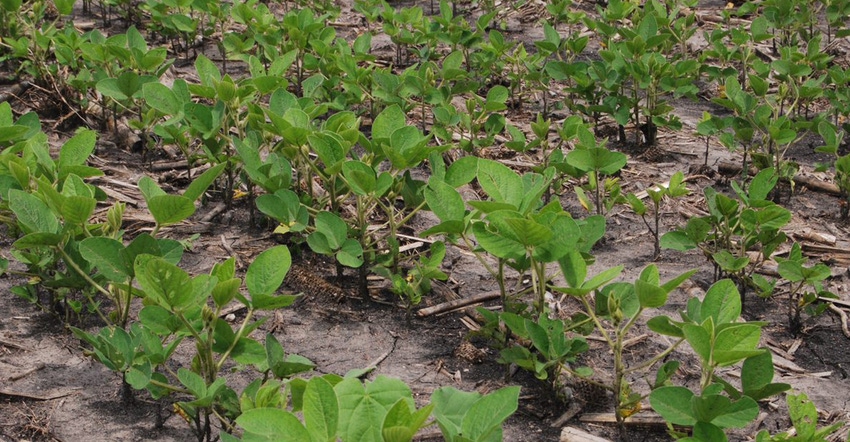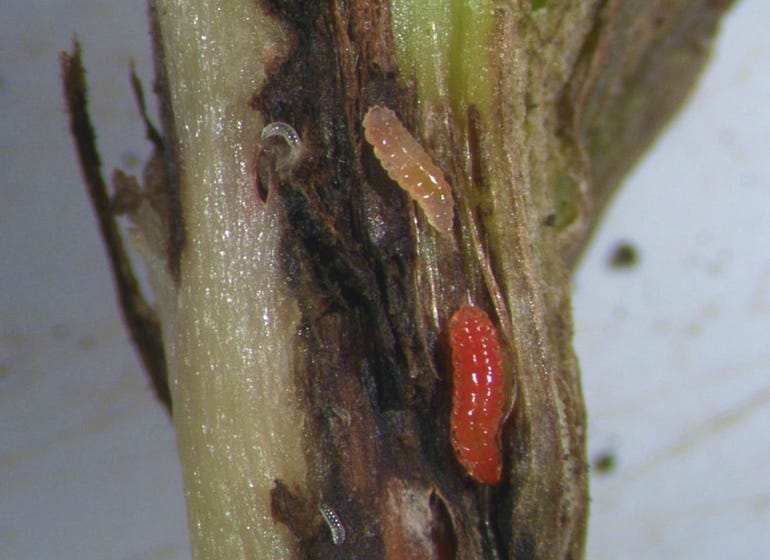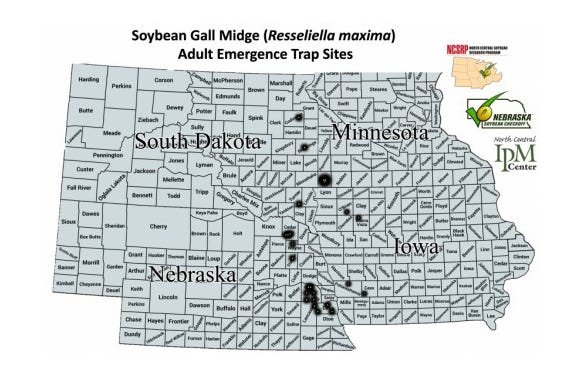June 19, 2019

Last year, the widespread outbreak of soybean gall midge took many farmers and entomologists by surprise. There was significant field edge injury and economic loss in at least 65 counties in Iowa, Nebraska, Minnesota and South Dakota. A small team of entomologists organized a concerted effort to learn more about the life cycle, biology and management of soybean gall midge in 2019.
“Our first step was to establish emergence cages in various habitat types to better understand where this insect overwinters,” says Erin Hodgson, Iowa State University Extension entomologist. “We used corn rootworm style traps to collect the midge adults emerging from the ground. The adults are a small, flying insect. A series of traps in Iowa, Nebraska and South Dakota have been monitored for several weeks this spring.”
As adults, midges are small, have long antennae and unusually hairy wings. Most are fragile, weak fliers. Many of the various kinds of midges are considered economically important plant pests. However, some are predatory on aphids and mites. The midge larvae feed within the host plant tissue, creating abnormal growths called galls.
The adult stage of soybean gall midge looks similar to a type of fly. The adults lay eggs that hatch into larvae and burrow into soybean stems during the growing season. Injury is most severe along the field edges. This possibly indicates that the adult midge fly to new soybean fields the following growing season. Larval feeding and plant injury are usually restricted to the base of the plant.

MIDGE LARVAE: Gall midge adults look like flies and lay eggs that hatch into larvae, which burrow into soybean stalks.

Mitchell Helton, an ISU entomology graduate student, has been checking traps frequently. On June 14 he had the first positive detection from emergence cages. The first adult collected this year was at ISU’s Northwest Research Farm near Sutherland. This trap is in a field that was infested with midge in 2018. Just a few hours later, on June 14, entomologists in Nebraska also had their first positive detection near Eagle in the east-central part of the state.
Don’t spray too early
“We plan to continue adult emergence trapping this spring to help us understand peak activity for mating and laying eggs in soybean fields,” Hodgson says. “At this point, just a few individual midges in traps does not warrant using a foliar insecticide. But our plans are to make treatments when the number of adult captures increase. We will be sure to keep soybean growers updated on subsequent detections of this insect pest, and we will issue our application recommendations in the future — if and when insecticide treatments are needed.”
Hodgson cautions against spraying insecticide too early to try to control midge. Growers spraying too early may not have enough residual insecticide activity when midge adults emerge in the area, she notes. “And they may not be able to spray the field again in that period, depending on label restrictions limiting the effectiveness and increasing the likelihood for soybean plant injury from gall midge.”
She adds, “We think soybean gall midge can complete at least two generations in Iowa, but we don’t know how long a generation take to develop. We also assume it can overwinter in Iowa and does so as a pupa in the soil or leaf litter similar to other midges.”
Scouting guidelines
In addition to gall midge, soybean growers and crop scouts should be on the lookout for other soybean insect pests during the 2019 growing season. Hodgson offers the following observations and guidelines for managing defoliator insects — those that chew on and damage soybean leaves.

The most effective way to make treatment decisions for pests with chewing mouthparts (such as Japanese beetle, bean leaf beetle, caterpillars and grasshoppers) is to estimate defoliation. “I’m a lumper and don’t try too hard to distinguish feeding by species,” Hodgson says. “I look at the amount of defoliation of the soybean plants that is occurring in a field, no matter which insects are causing it.”
She adds, “Replicated data over multiple growing regions consistently shows economic thresholds for soybean are 30% defoliation when the bean plants are in the vegetative growth stages and 20% in the reproductive stages. This threshold applies to the entire field. Sometimes these pests cause significant injury along field margins and in that case perimeter treatments of insecticide may be more cost-effective, if it is practical to make treatments around the margins and edges of fields.”
Don’t overestimate defoliation
In a recent ICM News article, Hodgson provided a scouting guideline image to help make accurate defoliation estimates. In general, people tend to overestimate the amount of defoliation that is occurring, and they treat more often than necessary, she says. You can practice estimating the amount of defoliation with the drawings in the ICM article at the above-mentioned link. Also, Hodgson recently published a review article for Japanese beetles, which can help growers and crop scouts learn more about this corn and soybean pest.
Source: ISU, which is responsible for the information provided and is wholly owned by the source. Informa Business Media and its subsidiaries aren’t responsible for any of the content in this information asset.
You May Also Like




